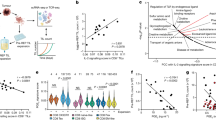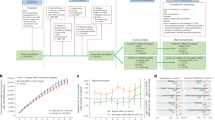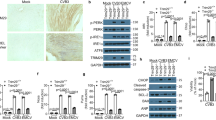Abstract
Host defence against influenza A virus (IAV) infection depends not only on host resistance to eliminate the virus, but also disease tolerance to limit lung tissue damage and maintain pulmonary function. Fatal IAV infections are frequently the result of a maladaptive immune response that compromises disease tolerance rather than host resistance to infection. Here, we show that the leukotriene B4 (LTB4)–type I interferon (IFN) axis promotes a distinct mechanism of disease tolerance to pulmonary IAV infection. We demonstrate that mice genetically deficient in LTB4 signalling (Blt1R−/−) are more susceptible to IAV infection compared to control mice, despite similar pulmonary viral loads. The increased susceptibility of Blt1R−/− mice is associated with an accumulation of inflammatory monocyte-derived macrophages (IMMs) causing increased lung immunopathology. We mechanistically define that LTB4 signalling via the BLT1 receptor enhances the activation of the type I IFN-α/β receptor (IFNAR)/ and signal transducer and activator of transcription 1 (STAT1), which leads to IFN-α production by interstitial macrophages to suppresse in situ IMM proliferation. Importantly, the delivery of a single dose of LTB4 at the peak viral load reduces IMM proliferation, controls tissue damage and increases survival without affecting host resistance to IAV. These results reveal an unexpected anti-inflammatory role of LTB4 in disease tolerance to IAV infection.
This is a preview of subscription content, access via your institution
Access options
Access Nature and 54 other Nature Portfolio journals
Get Nature+, our best-value online-access subscription
$29.99 / 30 days
cancel any time
Subscribe to this journal
Receive 12 digital issues and online access to articles
$119.00 per year
only $9.92 per issue
Buy this article
- Purchase on Springer Link
- Instant access to full article PDF
Prices may be subject to local taxes which are calculated during checkout






Similar content being viewed by others
Data availability
The data that support the findings of this study are available from the corresponding author upon request.
References
Soares, M. P., Teixeira, L. & Moita, L. F. Disease tolerance and immunity in host protection against infection. Nat. Rev. Immunol. 17, 83–96 (2017).
Medzhitov, R., Schneider, D. S. & Soares, M. P. Disease tolerance as a defense strategy. Science 335, 936–941 (2012).
Perrone, L. A., Plowden, J. K., Garcia-Sastre, A., Katz, J. M. & Tumpey, T. M. H5N1 and 1918 pandemic influenza virus infection results in early and excessive infiltration of macrophages and neutrophils in the lungs of mice. PLoS Pathog. 4, e1000115 (2008).
Short, K. R. et al. Influenza virus damages the alveolar barrier by disrupting epithelial cell tight junctions. Eur. Respir. J. 47, 954–966 (2016).
Lin, K. L., Suzuki, Y., Nakano, H., Ramsburg, E. & Gunn, M. D. CCR2+ monocyte-derived dendritic cells and exudate macrophages produce influenza-induced pulmonary immune pathology and mortality. J. Immunol. 180, 2562–2572 (2008).
Herold, S. et al. Lung epithelial apoptosis in influenza virus pneumonia: the role of macrophage-expressed TNF-related apoptosis-inducing ligand. J. Exp. Med. 205, 3065–3077 (2008).
Dawson, T. C., Beck, M. A., Kuziel, W. A., Henderson, F. & Maeda, N. Contrasting effects of CCR5 and CCR2 deficiency in the pulmonary inflammatory response to influenza A virus. Am. J. Pathol. 156, 1951–1959 (2000).
Coulombe, F. et al. Targeted prostaglandin E2 inhibition enhances antiviral immunity through induction of type I interferon and apoptosis in macrophages. Immunity 40, 554–568 (2014).
Aldridge, J. R. Jr et al. TNF/iNOS-producing dendritic cells are the necessary evil of lethal influenza virus infection. Proc. Natl Acad. Sci. USA 106, 5306–5311 (2009).
Teijaro, J. R., Walsh, K. B., Rice, S., Rosen, H. & Oldstone, M. B. Mapping the innate signaling cascade essential for cytokine storm during influenza virus infection. Proc. Natl Acad. Sci. USA 111, 3799–3804 (2014).
Boring, L. et al. Impaired monocyte migration and reduced type 1 (Th1) cytokine responses in C-C chemokine receptor 2 knockout mice. J. Clin. Invest 100, 2552–2561 (1997).
Sato, M. et al. Distinct and essential roles of transcription factors IRF-3 and IRF-7 in response to viruses for IFN-α/β gene induction. Immunity 13, 539–548 (2000).
Divangahi, M., King, I. L. & Pernet, E. Alveolar macrophages and type I IFN in airway homeostasis and immunity. Trends Immunol. 36, 307–314 (2015).
Jaworska, J. et al. NLRX1 prevents mitochondrial induced apoptosis and enhances macrophage antiviral immunity by interacting with influenza virus PB1-F2 protein. Proc. Natl Acad. Sci. USA 111, E2110–E2119 (2014).
Downey, J. et al. RIPK3 interacts with MAVS to regulate type I IFN-mediated immunity to influenza A virus infection. PLoS Pathog. 13, e1006326 (2017).
Morita, M. et al. The lipid mediator protectin D1 inhibits influenza virus replication and improves severe influenza. Cell 153, 112–125 (2013).
Brandt, S. L. & Serezani, C. H. Too much of a good thing: how modulating LTB4 actions restore host defense in homeostasis or disease. Semin. Immunol. 33, 37–43 (2017).
Gaudreault, E. & Gosselin, J. Leukotriene B4 induces release of antimicrobial peptides in lungs of virally infected mice. J. Immunol. 180, 6211–6221 (2008).
Majer, O. et al. Type I interferons promote fatal immunopathology by regulating inflammatory monocytes and neutrophils during Candida infections. PLoS Pathog. 8, e1002811 (2012).
Jenkins, S. J. et al. Local macrophage proliferation, rather than recruitment from the blood, is a signature of TH2 inflammation. Science 332, 1284–1288 (2011).
Robbins, C. S. et al. Local proliferation dominates lesional macrophage accumulation in atherosclerosis. Nat. Med. 19, 1166–1172 (2013).
Bleriot, C. et al. Liver-resident macrophage necroptosis orchestrates type 1 microbicidal inflammation and type-2-mediated tissue repair during bacterial infection. Immunity 42, 145–158 (2015).
Hwang, S. Y. et al. A null mutation in the gene encoding a type I interferon receptor component eliminates antiproliferative and antiviral responses to interferons alpha and beta and alters macrophage responses. Proc. Natl Acad. Sci. USA 92, 11284–11288 (1995).
De Weerd, N. A. et al. Structural basis of a unique interferon-β signaling axis mediated via the receptor IFNAR1. Nat. Immunol. 14, 901–907 (2013).
Gibbings, S. L. et al. Three unique interstitial macrophages in the murine lung at steady state. Am. J. Respir. Cell Mol. Biol. 57, 66–76 (2017).
Jung, S. et al. Analysis of fractalkine receptor CX3CR1 function by targeted deletion and green fluorescent protein reporter gene insertion. Mol. Cell. Biol. 20, 4106–4114 (2000).
Serezani, C. H., Lewis, C., Jancar, S. & Peters-Golden, M. Leukotriene B4 amplifies NF-κB activation in mouse macrophages by reducing SOCS1 inhibition of MyD88 expression. J. Clin. Invest. 121, 671–682 (2011).
Iwasaki, A. & Pillai, P. S. Innate immunity to influenza virus infection. Nat. Rev. Immunol. 14, 315–328 (2014).
Davies, L. C. et al. Distinct bone marrow-derived and tissue-resident macrophage lineages proliferate at key stages during inflammation. Nat. Commun. 4, 1886 (2013).
Tang, J. et al. Inhibiting macrophage proliferation suppresses atherosclerotic plaque inflammation. Sci. Adv. 1, e1400223 (2015).
Yoshimura, A., Naka, T. & Kubo, M. SOCS proteins, cytokine signalling and immune regulation. Nat. Rev. Immunol. 7, 454–465 (2007).
Piganis, R. A. et al. Suppressor of cytokine signaling (SOCS) 1 inhibits type I interferon (IFN) signaling via the interferon α receptor (IFNAR1)-associated tyrosine kinase Tyk2. J. Biol. Chem. 286, 33811–33818 (2011).
Davidson, S., Crotta, S., McCabe, T. M. & Wack, A. Pathogenic potential of interferon αβ in acute influenza infection. Nat. Commun. 5, 3864 (2014).
Channappanavar, R. et al. Dysregulated type I interferon and inflammatory monocyte-macrophage responses cause lethal pneumonia in SARS-CoV-infected mice. Cell Host Microbe 19, 181–193 (2016).
De Weerd, N. A. et al. Structural basis of a unique interferon-β signaling axis mediated via the receptor IFNAR1. Nat. Immunol. 14, 901–907 (2013).
Song, G., Ouyang, G. & Bao, S. The activation of Akt/PKB signaling pathway and cell survival. J. Cell. Mol. Med. 9, 59–71 (2005).
Bhatt, L., Roinestad, K., Van, T. & Springman, E. B. Recent advances in clinical development of leukotriene B4 pathway drugs. Semin. Immunol. 33, 65–73 (2017).
Mancuso, P., Lewis, C., Serezani, C. H., Goel, D. & Peters-Golden, M. Intrapulmonary administration of leukotriene B4 enhances pulmonary host defense against pneumococcal pneumonia. Infect. Immun. 78, 2264–2271 (2010).
Mancuso, P., Nana-Sinkam, P. & Peters-Golden, M. Leukotriene B4 augments neutrophil phagocytosis of Klebsiella pneumoniae. Infect. Immun. 69, 2011–2016 (2001).
Morato-Marques, M. et al. Leukotrienes target F-actin/cofilin-1 to enhance alveolar macrophage anti-fungal activity. J. Biol. Chem. 286, 28902–28913 (2011).
Brandt, S. L. & Serezani, C. H. Too much of a good thing: how modulating LTB4 actions restore host defense in homeostasis or disease. Semin. Immunol. 33, 37–43 (2017).
Gaush, C. R. & Smith, T. F. Replication and plaque assay of influenza virus in an established line of canine kidney cells. Appl. Microbiol. 16, 588–594 (1968).
Feoktistova, M., Geserick, P. & Leverkus, M. Crystal violet assay for determining viability of cultured cells. Cold Spring Harb. Protoc. 2016, 343–346 (2016).
Acknowledgements
This work was supported by a Canadian Institute of Health Research Foundation Grant (FDN-143273 to M.D.). M.D. holds a Fonds de Recherche du Québec–Santé Award and the Strauss Chair in Respiratory Diseases. E.P. is supported by a Fonds de Recherche du Québec–Santé Fellowship. J.D. is supported by the Research Institute of the McGill University Health Center. The funders had no role in study design, data collection and analysis, decision to publish or preparation of the manuscript.
Author information
Authors and Affiliations
Contributions
E.P. and M.D. conceived the project and designed the experiments. E.P. and J.D. performed the experiments. E.P., J.D. and M.D. analysed the data. W.S.P. and D.C.V. advised on the experiments. E.P. and M.D. wrote the paper. M.D. supervised the project.
Corresponding author
Ethics declarations
Competing interests
The authors declare no competing interests.
Additional information
Publisher’s note: Springer Nature remains neutral with regard to jurisdictional claims in published maps and institutional affiliations.
Supplementary information
Supplementary Information
Supplementary Figures 1–7 and Supplementary Table 1.
Rights and permissions
About this article
Cite this article
Pernet, E., Downey, J., Vinh, D.C. et al. Leukotriene B4–type I interferon axis regulates macrophage-mediated disease tolerance to influenza infection. Nat Microbiol 4, 1389–1400 (2019). https://doi.org/10.1038/s41564-019-0444-3
Received:
Accepted:
Published:
Issue Date:
DOI: https://doi.org/10.1038/s41564-019-0444-3
This article is cited by
-
Neonatal imprinting of alveolar macrophages via neutrophil-derived 12-HETE
Nature (2023)
-
Mild COVID-19 imprints a long-term inflammatory eicosanoid- and chemokine memory in monocyte-derived macrophages
Mucosal Immunology (2022)
-
Simultaneous profiling and quantification of 25 eicosanoids in human serum by ultrahigh-performance liquid chromatography coupled to tandem mass spectrometry
Analytical and Bioanalytical Chemistry (2022)
-
Structural insights on ligand recognition at the human leukotriene B4 receptor 1
Nature Communications (2021)
-
Effects of maoto (ma-huang-tang) on host lipid mediator and transcriptome signature in influenza virus infection
Scientific Reports (2021)



